Diablo IV: Vessel of Hatred. {Esp-Eng}
The first year of Diablo IV's life has been as exciting as it has been hopeful. Upon launch, Blizzard's title proved to be a fantastic action-RPG adventure that captivated us with its delightful gameplay and spectacular art direction, which recaptured the dark and decadent tone of the first two installments in the series. However, the content available once we completed the campaign was a bit sparse, and the loot system wasn't entirely well-tuned. The arrival of its first season didn't do much to change this situation, but from then on, Blizzard changed its way of doing things and began a gigantic and ambitious renovation project, the results of which we've seen in recent years. New and engaging content, a completely redesigned loot system that makes each piece of gear much more useful and important, giving us greater flexibility when building and strengthening our heroes, new and enjoyable ways to level up, and generous seasons that give us plenty of time to complete them. There's no doubt that Diablo IV is now a much better game than the one we had in its early days, and it's clear that the developer has been very attentive to the community, listening to their complaints and requests to shape a title that aspires to last for decades. Now, this renewal reaches its climax with Vessel of Hatred, its first major expansion and the definitive confirmation that this is the path forward.
Adventures in Nahantu
The first thing you should know about it is that it offers a new act that continues the story of the base title from where it left off. Thus, we follow the steps of Neyrelle, who has fled to the Nahantu region with Mephisto's Soulstone to try to contain his evil and prevent the Lord of Hatred from escaping his prison and threatening all of Sanctuary.
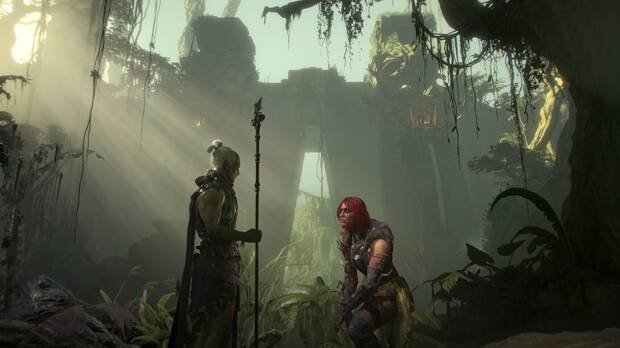
If you've already completed the base game's campaign, you can skip it when creating a new character and begin the expansion's story with them from level 1.
While I won't give you any further details to avoid spoiling anything, we're happy to confirm that the story has seen a tremendous improvement compared to what we saw in the main game. The script is better written and structured, has a much faster pace, reveals long-awaited and compelling insights into the saga's universe, and truly engages us with everything we're told. It now has a more adventurous feel, with moments that even reminded us of Indiana Jones as we explored ancient ruins and temples filled with traps and challenges to unravel their mysteries. However, what stands out most about the narrative is that the human element has been enhanced, giving much greater weight to the small group of protagonists and making our hero much more expressive than before and with a more defined personality. Make no mistake, this is still Diablo, and we'll find plenty of cruel and dark moments, but it does bring a little more light and hope when it needs to, a counterpoint that we believe greatly benefits the story's development. And yes, the video sequences are once again meticulously crafted and maintain impeccable technical quality. Our only complaint with the script is that the game's overall plot progresses very little, leaving us hanging and with a very open ending that suggests everything we've played is a mere prologue to what's yet to come.
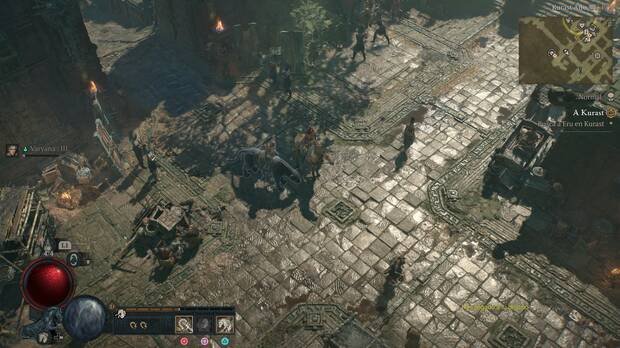
Vessel of Hatred's story lasts between 8 and 10 hours.
In terms of pure gameplay, the Nahantu region (the same one we explored in the third act of Diablo II) surprised us with its size and superb design. It's a massive jungle that brings with it tons of new dungeons, around twenty side quests, new altars to find, new towns and forts, tons of new world events, and, of course, countless new demons to slay. Yes, it's more of the same, but we had a great time exploring, completing content, and learning how to navigate through a variety of settings that skillfully combine labyrinthine sections with more open ones. Visually, it's also a marvel, delivering gorgeous shots that showcase the beauty found in Sanctuary alongside others that look straight out of our worst nightmares—further proof that this installment's art direction is in a league few can compete with. Something that really caught our attention was the improvement in boss fights, which are far more creative and surprising than in the main title. It's clear that the designers have put their all into creating tons of confrontations with unique mechanics and attack patterns that demand more. Simply hit and dodge while these powerful enemies phase-shift and become increasingly deadly.

The spirit realm plays a major role in the storyline of this expansion.
As we've said, these are incredibly fun, exciting, and challenging fights that even allow themselves the luxury of including epic narrative moments and playing with camera positioning to enhance the setting.
The Spiritualist
Another of the great new features in this expansion is the Spiritualist, a completely new class never before seen in the series that has automatically become our favorite in the entire game. This is an incredibly versatile melee combatant that can summon the power of four different spirits with their own unique effects. Thus, the Gorilla's abilities tend to focus on defense and physical damage; the Eagle unleashes electrical powers capable of leaving opponents vulnerable; the Jaguar is associated with fire, and its abilities grant us Ferocity charges that increase our attack speed to unimaginable limits; and the Centipede is ideal for lovers of poison and damage over time.
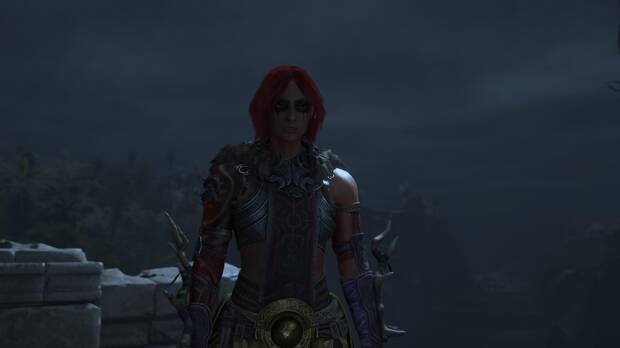
The Spiritualist is one of the most fun classes we've ever played in the series.
As we said, it's a class that stands out for its versatility and allows us to make all kinds of builds. At first, we tried builds focused on a single element to enhance its attributes, although it wasn't until we began experimenting with combining abilities from different spirits that we realized the enormous possibilities it holds and the deadly and fun-to-play characters we can develop. It's a marvel that can adapt to the needs and preferences of any player, so we strongly recommend that you try becoming a Spiritualist, as we're convinced you'll have the time of your life slaughtering demons with it. Continuing with the new features, we can't forget to mention the Undercity and the Dark Citadel, two new types of content that we really enjoyed and that have their own space within the game as a whole. On the one hand, the Undercity is a dungeon in which we have to advance against the clock.
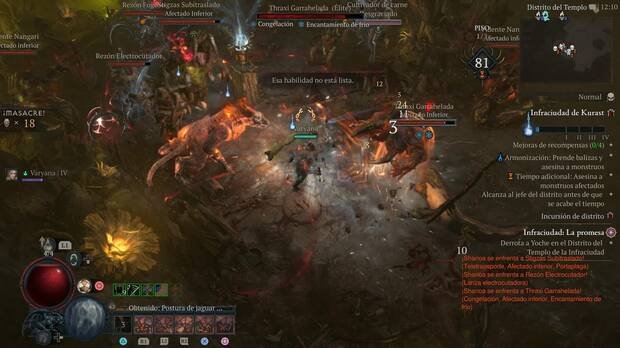
The Undercity is a frenetic content that doesn't allow a single second of respite. The exception is the bosses, where the countdown timer disappears.
If we play without modifiers, upon entering it we have 100 seconds to descend several floors and reach the boss of the wing we entered. As you might guess, that's not enough time for such a task, so we must find and kill creatures that add seconds to our timer while we search for the exit that leads us to the next floor. To make things more interesting, there's a soul meter that we can fill by eliminating enemies and completing certain events scattered throughout the dungeon. The more we fill it, the better the reward at the end, so our progress is always marked by finding the balance between moving quickly and collecting souls. We have 30 seconds left; do we risk completing that event to add souls or go directly to the next floor to recover seconds and ensure we don't fail even if the loot is less? It's all so frenetic that we hardly have time to think, so the decisions we make are usually very instinctive, which makes the Undercity a very enjoyable and recommendable place to level up and acquire gear. Plus, it fits perfectly into Diablo IV's gameplay loop, offering simple, straightforward, and uncomplicated fun so you'll never get bored slaughtering the creatures of Hell.
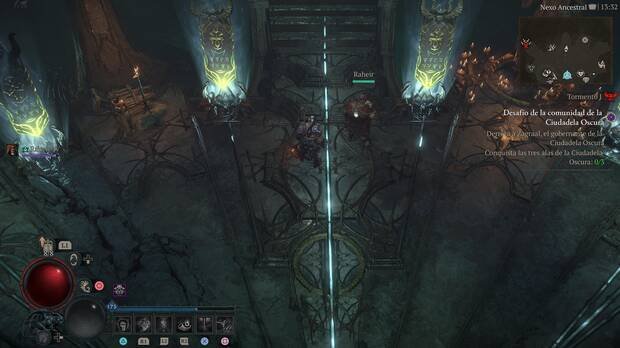
Three challenging wings await you to conquer in the Dark Citadel.
The Dark Citadel, on the other hand, is content for high-level players that can only be completed in groups of 2 to 4 players and on Torment difficulty levels. It's a gigantic dungeon divided into three distinct wings where the toughest and most complicated challenges of the entire game await. What's truly interesting about it is that, unlike what we're used to, it's not just about killing enemies; we'll also have to solve puzzles and challenges that will test our ingenuity and ability to cooperate with our companions. They have many unique mechanics, as well as moments where we'll be forced to separate from our friends to follow different paths, performing coordinated actions. In fact, cooperation is so important that we'll even have to synchronize to be able to damage and take down the bosses that await us at the end of each wing and survive their complex mechanics. A leaderboard system has even been added so we can communicate without having to speak.
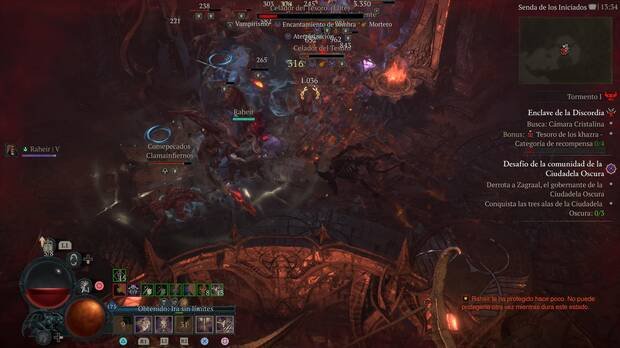
We don't know if, in the long run, it will become tiresome content, but right now it seems to us to be some of the best content ever created for a Diablo game. It has a fantastic design, hides tons of secrets, the trials are fun, intense, and very challenging, the puzzles are well thought out, and it's the first time we've had the impression that player cooperation has been taken to a level beyond what is usual in the series. Other improvements and additions
Of course, in addition to everything mentioned above, you can also expect completely new pieces of equipment that open up tons of new possibilities when it comes to building our characters, regardless of class, with new power-ups and traits that we're convinced will be a great resource for those looking to maximize the efficiency of their heroes. In fact, builds now gain in complexity thanks to the addition of runes, a new item that can be placed in the slots of our equipment that until now were only used to socket gems. There are two types of runes: summoning and ritual.
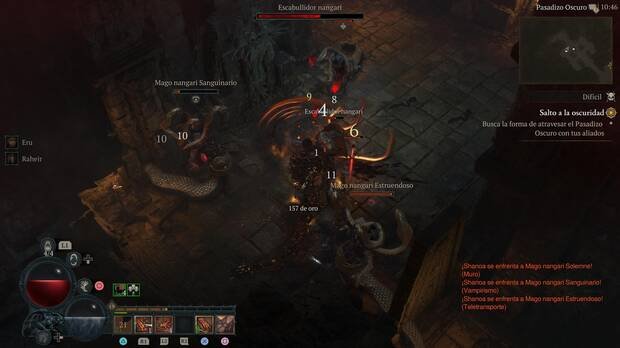
The tweaks, adjustments, and redesigns made to the various progression systems greatly improve the experience.
To use them, we must create rune words by placing a summoning rune and a ritual rune on the same piece of equipment. Depending on which ones we place, we can access certain effects when we meet the requirements for their activation, which can be of all kinds, such as being able to use a skill from a class other than our own. As you can imagine, there are a large number of different combinations with their own effects, so we'll have to decide which pieces of equipment we want to socket gems into and which runes into, opening up endless possibilities to develop our hero and adapt it to our preferences. We can't forget that Vessel of Hatred also brings back mercenaries, characters we can hire to help us on our adventure when playing solo. We liked its implementation much more than in Diablo II and Diablo III, since here we don't have to worry about their health and they serve a supportive role, allowing us to cover our class's weaknesses and grant us all kinds of buffs and beneficial effects.

By fighting alongside a mercenary, you'll increase your affinity level with them, allowing you to earn rewards and unlock skills in their talent trees.
Furthermore, the side quests to unlock them are well-developed, and they all have very distinct personalities and truly interesting story backgrounds, making it easy to end up enjoying their company and considering them true comrades in arms. Beyond the expansion's new content, a massive free update has also been released for all players that brings significant changes to some key aspects of the game. For starters, character and Legend levels are now independent, and the latter are shared between all our avatars. Thus, level 60 is the maximum we can aspire to, and when we reach that level, our Legend panels will be unlocked with all the points we've accumulated across all our heroes. A change that, honestly, we think is better and streamlines the process of gearing up and becoming stronger. Additionally, a new Legendary node has been added to each panel.
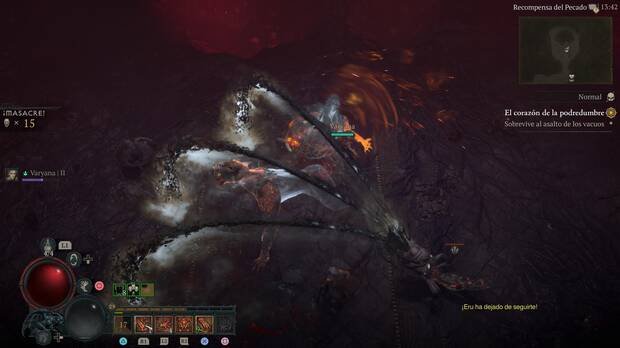
Now, reaching level 60 is a much faster process than before.
It's also important to note that the difficulty levels are now divided between Standard and Torment, so there are many more to choose from, as well as several Torment levels to advance through as we gear up. Another new feature worth celebrating is the addition of a group finder, something that will make our lives much easier when it comes to finding comrades in arms for all kinds of activities. It works quite well, is well organized, and it's very easy to both create a group and find one to join. Of course, there are also countless changes, tweaks, improvements, and more specific additions that, while smaller, add up and make Diablo IV a much better game than before. These include the way glyphs have been updated to fit in with the rest of the changes, the new passives added to classes, the new legendaries and uniques introduced, and much more, all of which you can check out in detail on the game's official website.
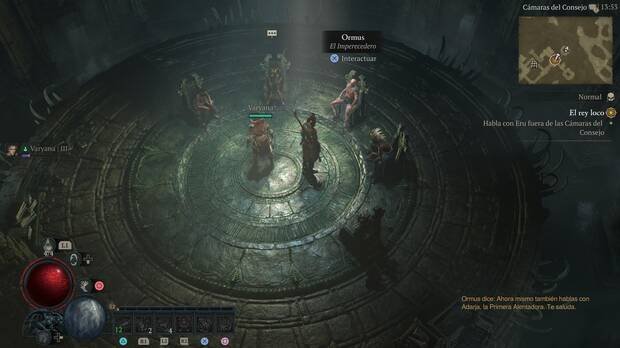
Few games can compete with Diablo IV's art direction, and its expansion is no exception. And by the way, before closing this review, we'd like to applaud the expansion's sound: simply overwhelming. The soundtrack features two hours of new music that we think is some of the best we've heard in the series, taking on even more prominence than before and using new instruments to create pieces that perfectly capture the atmosphere of everything we see on screen, reinforcing every scene and every moment of the game. It also allows itself the luxury of revisiting some very legendary and iconic compositions that have a very clear narrative intent. Of course, the effects aren't far behind, and we found the Spanish dubbing to be more inspired than the base title, although the accents of certain characters in the English version are still missing.
Conclusions
Diablo IV: Vessel of Hatred is an outstanding expansion packed with content that fascinated us. Finally, the saga's narrative is back on track with an interesting and well-constructed story. The new content is a lot of fun and fits perfectly into the gameplay loop. The Spiritualist is one of the best and most fun classes we've ever played in a series installment. The mercenary system is very well implemented. The runes and new pieces of equipment bring countless new possibilities when it comes to creating our build. The balance adjustments and redesign of the Legend and difficulty levels were necessary.
Yes, this is still more Diablo IV, but it's a better and more straightforward version that elevates the gaming experience to something far superior to what we were able to play a year ago. And all of this while maintaining its exquisite and frenetic gameplay, which is mainly responsible for making massacring demons much more fun and enjoyable at the controls than in any of its competitors. If you like the series and are looking for a game to invest tens or hundreds of hours of your life in over the next few months, don't think twice: this expansion will give you exactly what you want.
____________________
Español
⬇️
El primer año de vida de Diablo IV ha sido tan apasionante como esperanzador. Durante su lanzamiento, el título de Blizzard demostró ser una aventura de rol y acción fantástica que nos enamoró con su deliciosa jugabilidad y su espectacular dirección de arte, la cual recuperó el tono oscuro y decadente de las dos primeras entregas de la saga. Sin embargo, los contenidos disponibles una vez terminábamos la campaña se quedaban un poco escasos y el sistema de botín no estaba del todo bien ajustado. La llegada de su primera temporada no hizo demasiado por cambiar esta situación, pero a partir de entonces, Blizzard cambió su forma de hacer las cosas y empezó un gigantesco y ambicioso proyecto de renovación cuyos resultados hemos visto durante los últimos tiempos. Nuevos y atractivos contenidos, un sistema de botín totalmente rediseñado que hace que cada pieza de equipo que sea mucho más útil e importante para darnos una mayor flexibilidad a la hora de construir a nuestro héroe y fortalecerlo, nuevas y amenas formas de subir de nivel, temporadas muy generosas que nos dan tiempo de sobra para completarlas.
No cabe duda que Diablo IV es ahora un juego muchísimo mejor que el que tuvimos durante sus primeros días y se nota que la desarrolladora ha estado muy atenta a la comunidad, escuchando sus quejas y peticiones para darle forma a un título que aspira a durar lustros. Ahora, esta renovación llega a su punto culminante con Vessel of Hatred, su primera gran expansión y la confirmación definitiva de que este es el camino a seguir.
De aventuras por Nahantu
Lo primero que debéis saber sobre ella es que nos ofrece un nuevo acto que continúa la historia del título base desde el mismo punto en el que se quedó. De este modo, seguimos los pasos de Neyrelle, quien ha huido a la región de Nahantu con la piedra del alma de Mefisto para intentar contener su mal y evitar que el Señor del Odio escape de su prisión y amenace a todo Santuario.
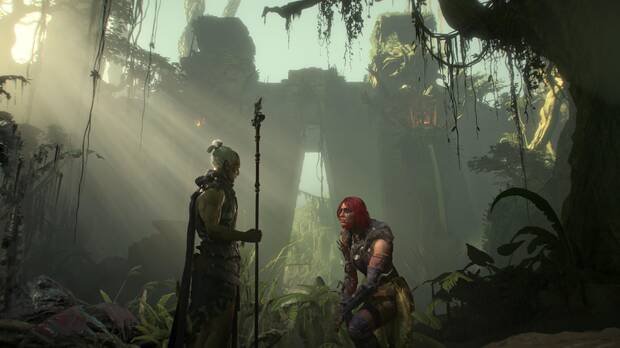
Si ya habéis completado la campaña del juego base, podéis omitirla al crear un nuevo personaje para empezar con él la historia de la expansión desde nivel 1.
Si bien no voy a daros más detalles para no caer en destripes, sí que nos alegra poder confirmar que la historia ha experimentado una mejora descomunal respecto a lo que nos narraron en el juego principal. El guion está mejor escrito y estructurado, tiene un ritmo muy superior, desvela cosas muy esperadas y atractivas sobre el universo de la saga y consigue que realmente nos interesemos por todo lo que nos cuentan. Ahora tiene un toque más aventurero, con momentos que incluso nos han recordado a Indiana Jones mientras explorábamos antiguas ruinas y templos repletos de trampas y desafíos para desentrañar sus misterios, aunque lo que más destaca sobre la narrativa es que se ha potenciado el factor humano, dándole un peso mucho mayor al pequeño grupo de protagonistas y haciendo que nuestro héroe sea bastante más expresivo que antes y tenga una personalidad más definida. No os equivoquéis, esto sigue siendo Diablo y no nos van a faltar infinidad de momentos crueles y sombríos, pero sí que aporta algo más de luz y esperanza cuando debe hacerlo, un contrapunto que creemos que le hace mucho bien al desarrollo de la historia. Y sí, las secuencias de vídeo vuelven a estar cuidadísimas y mantienen una factura técnica intachable. Nuestra única pega con el guion es que la trama general del juego como tal avanza poquísimo, dejándonos con la miel en los labios y con un final muy abierto que anticipa que todo lo que hemos jugado es un simple prólogo para lo que todavía está por venir.

La historia de Vessel of Hatred dura entre 8 y 10 horas.
En lo puramente jugable, la región de Nahantu (la misma que exploramos en el tercer acto de Diablo II) nos ha sorprendido con su tamaño y con su estupendo diseño. Es una jungla enorme que trae consigo montones de nuevas mazmorras, una veintena de misiones secundarias, nuevos altares que encontrar, nuevas ciudades y fuertes, muchos eventos de mundo nuevos y, por supuesto, infinidad de nuevos demonios a los que machacar. Sí, es más de lo mismo, pero nos lo hemos pasado genial explorando, completando contenidos y aprendiendo a movernos por unos escenarios muy variados que combinan con mucho acierto secciones laberínticas con otras más abiertas. Además, a nivel visual también es una maravilla y es capaz de regalarnos estampas preciosas que demuestran la belleza que puede llegar a encontrarse en Santuario con otras que parecen sacadas de nuestras peores pesadillas, una muestra más de que la dirección de arte de esta entrega juega en una liga en la que pocos pueden competir. Algo que nos ha llamado mucho la atención es la mejora que han experimentado los combates contra los jefes, bastante más creativos y sorprendentes que en el título principal. Se nota que sus diseñadores lo han dado todo para crear montones de enfrentamientos con mecánicas únicas y patrones de ataque que nos piden que hagamos algo más
que simplemente pegar y esquivar mientras estos poderosos enemigos van cambiando de fase y volviéndose cada vez más letales.
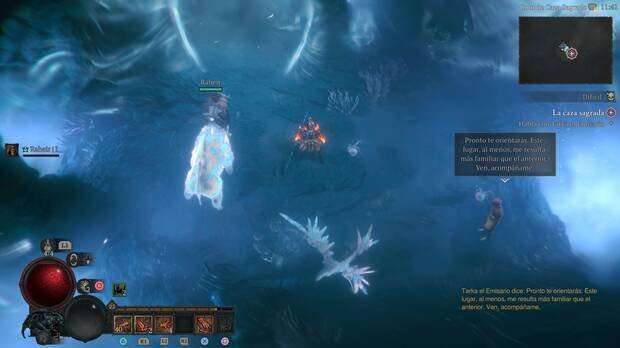
El reino de los espíritus tiene una gran importancia argumental en esta expansión.
Como decimos, son unas peleas divertidísimas, emocionantes y desafiantes que hasta se permiten el lujo de incluir momentos narrativos muy épicos y jugar con la posición de la cámara para reforzar la puesta en escena.
El Espiritualista
Otra de las grandes novedades de esta expansión la tenemos en el Espiritualista, una clase completamente nueva e inédita en la saga que se ha convertido, automáticamente, en nuestra favorita de todo el juego. Se trata de un combatiente cuerpo a cuerpo increíblemente versátil que puede invocar el poder de cuatro espíritus distintos con sus propios efectos. De este modo, las habilidades del Gorila suelen estar centradas en la defensa y el daño físico, con el Águila desatamos poderes eléctricos capaces de dejar vulnerables a los rivales, el Jaguar está asociado al fuego y sus habilidades nos dan cargas de Ferocidad que aumentan nuestra velocidad de ataque hasta límites insospechados y el Ciempiés es ideal para los amantes del veneno y el daño por tiempo.

El Espiritualista es una de las clases más divertidas que hemos jugado nunca en la saga.
Como decimos, se trata de una clase que destaca por su versatilidad y nos permite hacer todo tipo de construcciones. Al principio, probamos builds centradas en un único elemento para potenciar sus atributos, aunque no fue hasta que empezamos a experimentar combinando habilidades de distintos espíritus que fuimos conscientes de las enormes posibilidades que esconde y de los personajes tan letales y divertidos de jugar que podemos llegar a desarrollar. Es una maravilla capaz de adaptarse a las necesidades y preferencias de cualquier jugador, por lo que os recomendamos encarecidamente que probéis a haceros un Espiritualista, ya que estamos convencidos de que vais a disfrutar como nunca masacrando demonios con él. Continuando con las novedades, no podemos olvidarnos de mencionar la Infraciudad y la Ciudadela Oscura, dos nuevos tipos de contenidos que nos han gustado mucho y que tienen su propio espacio dentro del conjunto del juego. Por una parte, la Infraciudad es una mazmorra en la que tenemos que avanzar a contrarreloj.
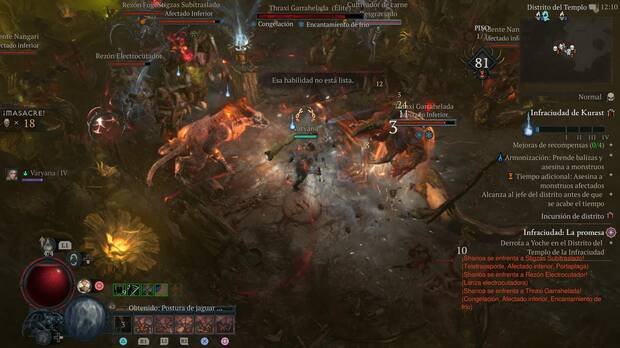
La Infraciudad es un contenido frenético que no deja ni un solo segundo de respiro. La excepción es en los jefes, donde desaparece la cuenta atrás.
Si jugamos sin modificadores, al adentrarnos en ella tenemos 100 segundos para bajar varios pisos y llegar hasta el jefe del ala en la que nos hayamos introducido. Como podréis suponer, ese tiempo es insuficiente para semejante tarea, así que debemos encontrar y matar criaturas que sumen segundos a nuestro contador mientras buscamos la salida que nos lleve a la siguiente planta. Para hacer las cosas más interesantes, existe un medidor de almas que podemos rellenar eliminando enemigos y completando ciertos eventos que hay repartidos por toda la mazmorra. Cuanto más lo llenemos, mejor será la recompensa al final, así que nuestro avance siempre está marcado por encontrar el equilibrio entre avanzar rápido y conseguir almas. Nos quedan 30 segundos, ¿nos arriesgamos a completar ese evento para sumar almas o pasamos directamente al siguiente piso para recuperar segundos y asegurarnos de no fracasar aunque el botín sea menor? Es todo tan frenético que casi no vamos a tener tiempo para pensar, por lo que las decisiones que tomamos suelen ser muy instintivas, lo que hace de la Infraciudad un contenido muy ameno y recomendable para subir de nivel y conseguir equipo. Además, encaja de lujo con el bucle jugable de Diablo IV, ofreciéndonos diversión simple, directa y sin complicaciones para que nunca nos aburramos masacrando criaturas del Infierno.
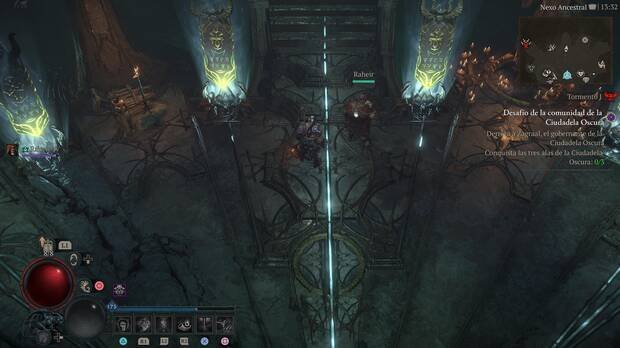
Os esperan tres desafiantes alas para conquistar en la Ciudadela Oscura.
En cambio, la Ciudadela Oscura es un contenido para jugadores de alto nivel que solo puede completarse en grupo de 2 a 4 jugadores y en los niveles de dificultad de Tormento. Se trata de una mazmorra gigantesca dividida en tres alas distintas donde nos esperan los desafíos más duros y complicados de todo el juego. Lo realmente interesante de ella es que, a diferencia de lo que estamos acostumbrados, aquí no se trata solo de matar enemigos, sino que también vamos a tener que resolver puzles y desafíos que van a poner a prueba nuestro ingenio y capacidad para cooperar con nuestros compañeros. Tienen muchas mecánicas únicas, así como momentos en los que nos van a obligar a separarnos de nuestros amigos para ir por caminos distintos realizando acciones de manera coordinada. De hecho, la cooperación es tan importante que incluso vamos a tener que sincronizarnos para poder dañar y tumbar a los jefes que nos aguardan al final de cada ala y sobrevivir a sus complejas mecánicas. Hasta se ha añadido un sistema de marcadores para que podamos comunicarnos sin necesidad de hablar.
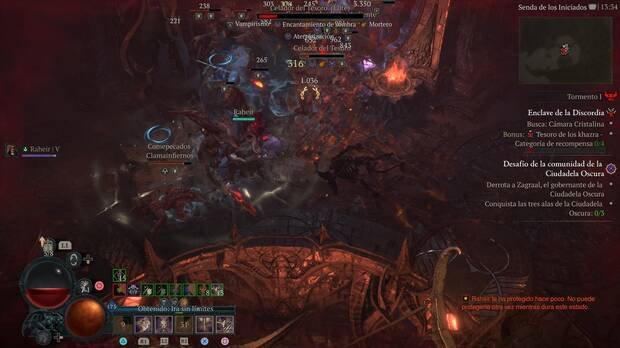
No sabemos si, a la larga, será un contenido que acabe cansando, pero ahora mismo nos parece uno de los mejores contenidos que se han creado nunca para un juego de Diablo. Tienen un diseño fantástico, esconden montones de secretos, las pruebas son divertidas, intensas y muy desafiantes, los rompecabezas están bien pensados y es la primera vez que hemos tenido la impresión de que la cooperación entre jugadores se lleva a un nivel más allá del habitual en la saga. Otras mejoras y añadidos
Por supuesto, además de todo lo comentado, también podéis esperar piezas de equipo completamente nuevas que nos abren montones de nuevas posibilidades a la hora de construir a nuestros personajes, sea de la clase que sea, con nuevos potenciadores y rasgos que estamos convencidos de que van a dar mucho juego a quienes busquen maximizar la eficiencia de sus héroes. De hecho, ahora las builds ganan en complejidad gracias al añadido de las runas, un nuevo ítem que podemos colocar en los huecos de nuestro equipo que hasta ahora solo se utilizaban para engarzar gemas. Existen dos tipos de runas: de invocación y de ritual.
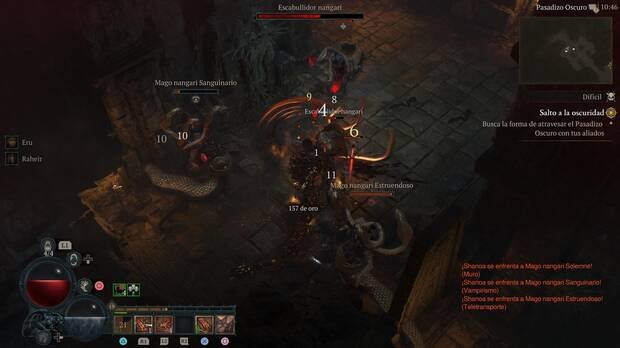
Los retoques, ajustes y rediseños que se han realizado a los distintos sistemas de progresión mejoran mucho la experiencia.
Para poder utilizarlas, tenemos que crear palabras rúnicas colocando una runa de invocación y una de ritual en una misma pieza de equipo. Según las que hayamos colocado, podremos acceder a unos efectos u otros cuando cumplamos los requisitos necesarios para que se activen, los cuales pueden ser de todo tipo, como que podamos poner en práctica una habilidad de una clase distinta a la nuestra. Como podréis intuir, hay un gran número de combinaciones distintas con sus propios efectos, así que nos tocará decidir en qué piezas de nuestro equipo queremos engarzar gemas y en cuáles runas, abriéndonos un sinfín de posibilidades para desarrollar a nuestro héroe y adaptarlo a nuestras preferencias. Tampoco podemos olvidarnos de que Vessel of Hatred trae consigo de vuelta a los mercenarios, personajes que podemos contratar para que nos ayuden en nuestra aventura cuando jugamos en solitario. Su implementación nos ha gustado bastante más que en Diablo II y Diablo III, ya que aquí no tenemos que preocuparnos de su vida y cumplen una función de apoyo, permitiéndonos cubrir los puntos débiles de nuestra clase para que nos otorguen toda clase de mejoras y efectos beneficiosos.
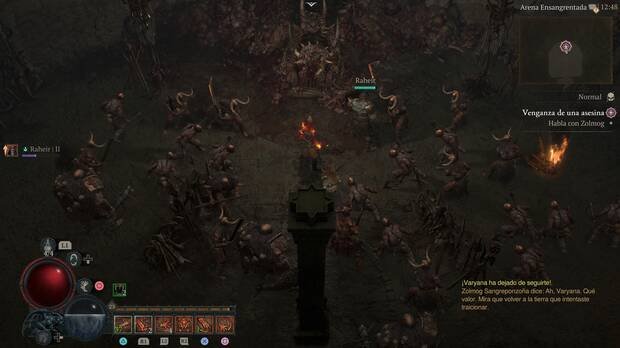
Al combatir junto a un mercenario subiréis vuestro nivel de afinidad con ellos, lo que os permitirá obtener recompensas y desbloquear habilidades en sus árboles de talentos.
Además, las misiones secundarias para desbloquearlos están muy trabajadas y todos tienen una personalidad muy marcada y unos trasfondos argumentales realmente interesantes, por lo que resulta fácil acabar disfrutando de su compañía y considerándolos auténticos compañeros de armas. Más allá de los nuevos contenidos de la expansión, también se ha lanzado una gigantesca actualización gratuita para todos los jugadores que trae consigo cambios importantísimos a algunos puntos clave del juego. Para empezar, ahora los niveles de personaje y de Leyenda son independientes, y estos últimos se comparten entre todos nuestros avatares. De esta forma, el nivel 60 es el máximo al que podemos aspirar y cuando lleguemos a esa cifra se desbloquearán nuestros paneles de Leyenda con todos los puntos que hayamos acumulado entre todos nuestros héroes, un cambio que, sinceramente, nos parece mejor y agiliza el proceso de equiparse y hacerse más fuertes. Además, a cada panel se le ha añadido un nuevo nodo legendario.
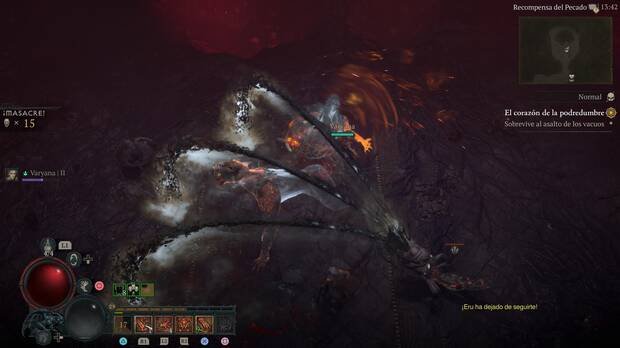
Ahora, subir a nivel 60 es un proceso mucho más rápido que antes.
También es importante destacar que ahora los niveles de dificultad se dividen entre estándar y Tormento, por lo que hay muchos más entre los que escoger, así como varios niveles de Tormento por los que ascender a medida que nos vayamos equipando. Otra novedad a celebrar la tenemos en el añadido de un buscador de grupos, algo que nos va a facilitar mucho la vida a la hora de buscar compañeros de armas para realizar toda clase de actividades. Funciona bastante bien, está bien organizado y resulta muy sencillo tanto crear un grupo como buscar alguno al que unirnos. Por supuesto, también hay infinidad de cambios, ajustes, mejoras y novedades más específicas que, a pesar de ser más "pequeñas", suman y hacen que Diablo IV sea un juego mucho mejor que antes, como la forma en la que se han actualizado los glifos para que encajen con el resto de cambios, las nuevas pasivas que se han añadido a las clases, los nuevos legendarios y únicos que se han introducido y muchas más cosas que podéis consultar en detalle desde la web oficial del juego.
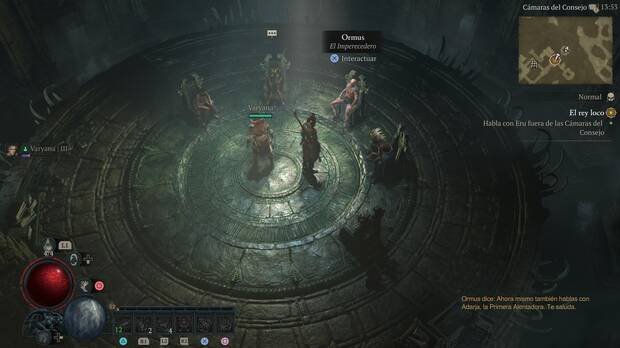
Pocos juegos existen que puedan competir con la dirección de arte de Diablo IV y su expansión no es una excepción.
Y por cierto, antes de cerrar este análisis, nos gustaría aplaudir el apartado sonoro de la expansión: simplemente apabullante. La banda sonora suma dos horas de nuevos temas musicales que nos han parecido de lo mejor que hemos escuchado en la saga, cobrando incluso más protagonismo que antes y jugando con nuevos instrumentos para crear unas piezas que captan a la perfección el ambiente de todo lo que vemos en pantalla para reforzar cada escena y cada momento de la partida. Además, se permite el lujo de revisitar algunas composiciones muy míticas e icónicas que tienen una intención narrativa muy clara. Por supuesto, los efectos tampoco se quedan atrás y el doblaje al español lo hemos notado más inspirado que en el título base, aunque se siguen perdiendo los acentos que tienen ciertos personajes en la versión inglesa.
Conclusiones
Diablo IV: Vessel of Hatred es una expansión sobresaliente y repleta de contenidos que nos ha fascinado. Por fin la narrativa de la saga vuelve a enderezarse con una historia interesante y bien construida, los nuevos contenidos son muy divertidos y encajan perfectamente dentro del bucle jugable, el Espiritualista es de las mejores y más divertidas clases con las que hemos jugado nunca en una entrega de la serie, el sistema de mercenarios está muy bien implementado, las runas y las nuevas piezas de equipo traen consigo infinidad de nuevas posibilidades a la hora de crear nuestra build y los ajustes de equilibrio y el rediseño de los niveles de Leyenda y de dificultad eran necesarios.
Sí, esto no deja de ser más Diablo IV, pero es un más y mejor de manual que eleva la experiencia de juego a algo muy superior a lo que pudimos jugar hace un año. Y todo ello manteniendo su exquisita y frenética jugabilidad, la principal culpable de hacer que masacrar demonios sea mucho más divertido y placentero a los mandos que en cualquiera de sus competidores. Si os gusta la saga y buscáis un juego en el que invertir decenas o cientos de horas de vuestra vida durante los próximos meses, no os lo penséis: esta expansión os va a dar justo lo que deseáis.
_____________________


created blog gif
_____________________
| Translation | Google Translate |
|---|---|
| Images | tomadas por mi |
Español
| Traducción | Traductor de Google |
|---|---|
| Imagenes | Taken by me |
Congratulations @infinitelove14k! You have completed the following achievement on the Hive blockchain And have been rewarded with New badge(s)
Your next target is to reach 4000 upvotes.
You can view your badges on your board and compare yourself to others in the Ranking
If you no longer want to receive notifications, reply to this comment with the word
STOPI'm currently trying to get a friend of mine to buy the game but its too much money for him to want to spend. So we are doing d2r. I have tried to get more friends into it but the hype from my friends is very low. Reading your post gave me some insite as to where d4 has kinda went since launch and gonna push to see if my friend will fork out the money to play it with me. When I downloaded the game when it first came out I was hoping for the greater rift feature that they had in d3 or something like it and weather or not they had it i never got to it. Thanks for your time to make this post.